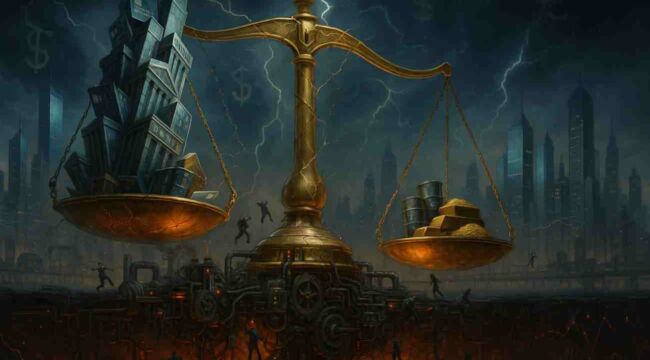Fringe Theories for a Faulty Financial System
We’re obviously living in tumultuous times. If investors sense they’re on a financial roller coaster, they’re right.
Recently, I scanned my market tickers and saw that everything was up. Stocks, bonds, gold, silver, the dollar, cryptos and commodities were all advancing. Of course, that didn’t last. The next day cryptos crashed and stocks were down sharply. Even gold suffered its worst day in a decade on Tuesday, a day after notching new record highs. In these markets, volatility is the one constant.
These types of markets demand discipline, but they also give rise to what I can only describe as fringe theories. Even highly seasoned market analysts with great reputations will write to me with theories they’ve heard asking what I think about them. We don’t have space to go into all of them (and many are just nonsense and not worth going into), but the main theme is that somehow the U.S. Treasury is working on a technical default on government debt.
Theory #1 – A U.S. Debt Default
The easiest way to default is simple inflation. Even 4% inflation will cut the value of the dollar in half in just 18 years and half again in another 18 years. That means the dollar will lose more than 75% of its purchasing power in a typical 40-year career beginning at age 23 and retiring at age 63. Inflation higher than 4% will decimate the dollar even faster. The simplest form of protection is to allocate half your portfolio to hard assets like gold, silver, land or other natural resources.
There will not be a formal default on U.S. Treasury debt or anything like it, including forced debt swaps or maturity swaps. The U.S. can always find buyers for Treasury debt, starting with the big U.S. banks and the Fed if needed. Inflation is still a risk (as noted above), but outright default will not happen and it is not necessary.
This does not mean that high deficits and high debts are a free ride. The key metric is the debt-to-GDP ratio. Right now, the U.S. debt-to-GDP ratio is 124%. Anything above 90% has a Keynesian multiplier < 1. You can still borrow your way to some growth as Joe Biden did, but the ratio just gets higher, and growth slows even more. The key is to lower the ratio. That’s what the market is looking for and what Trump is trying to deliver.
You can still have high debt and deficits. But if the debt-to-GDP ratio is dropping, we’re moving in the right direction, and the market will give the U.S. time. That ratio dropped from 114% in 1945 to 32% in 1980, so we’ve been here before and got out of it over the course of 35 years. Deficits and annual debt were both 3 times higher in 1980 than in 1945, but growth was 10 times higher, so the ratio dwindled. That’s the key.
What’s impressive about the U.S. effort to lower the debt-to-GDP ratio between 1945 and 1980 was that it was bipartisan. That effort was pursued by Democrats like Harry Truman, JFK, LBJ, and Jimmy Carter as well as Republicans like Dwight Eisenhower, Richard Nixon and Gerald Ford. It was not a highly politicized issue. Leaders knew what needed to be done and they did it. They may have argued about everything else, but the need to reduce the debt ratio was not politicized. Unfortunately, that’s not true today, which makes the task more difficult.
Theory #2 – A Dual Debt System
Another theory floating around is that the U.S. will go to a dual debt system with a gold-backed dollar for domestic transactions and a pure paper dollar for foreign transactions. That’s extremely unlikely.
Dual systems don’t work absent extreme capital controls. The reason is arbitrage. Once you create any kind of dual system using the same currency (and gold), hedge funds will drive the two types of dollars to parity or make the holders of paper dollars go broke in the process.
Another side effect would be Gresham’s Law, which says that bad money drives out good. As applied to this scheme, investors would hoard the “gold dollars” and dump the “paper dollars” at every opportunity. Sooner than later, no gold dollars would be found.
A Global Liquidity Crisis
No one really understands the dollar. People talk about the dollar being “up” or “down” or “sideways.” My question is: compared to what? On a given day, the dollar can be up against the yen, down against gold and sideways against the euro. Was the dollar up, down or sideways that day? It was all three. You can’t have an intelligent conversation about dollar valuation until you define your metric.
I use gold because it’s money, but it’s not a currency. Gold still plays an important role in the fate of the dollar.
If you use gold as a way to measure the dollar, don’t look at the dollar price per ounce. Instead, ask what weight of gold you get for $1.00. The answer in 1971 was 0.02857 ounces. The answer in 1980 was 0.00125 ounces. That’s a 95.6% devaluation in nine years. That was the real collapse of the dollar, but everyone missed it because they were looking at yen, sterling and Deutsche Marks.
If you had the same devaluation (measured by weight of gold) today, then gold would be over $94,000 per ounce. Again, there’s your devaluation. I’m not necessarily forecasting that price level, but history says we should not rule it out.
That said, the dollar compared to other currencies is strong and getting stronger. There’s a global dollar shortage. To find it, don’t look at the central banks; look at commercial Eurodollar banks.
The Treasury monthly TIC reports show that foreign central banks are not dumping Treasuries. They wish they had more. To the extent they sell any (or let them roll off at maturity), it’s because they’re desperate for the cash to prop up their own currency or bail out their own banks. Treasuries are dollar-denominated, but they are not dollars. You have to sell them to get dollars. Based on this global dollar shortage, we may be on the verge of a global liquidity crisis.
The truth is we don’t have to search for fringe theories to see if there’s something wrong with the financial system. The evidence is all around us hiding in plain sight.



Comments: